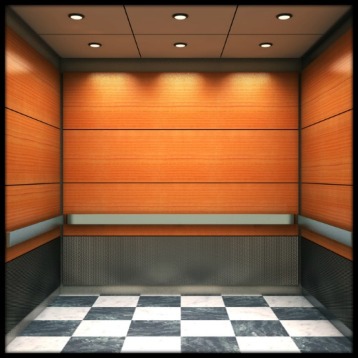For several minutes a day many people are confined to a five-foot by six-foot space with five to ten other people in an elevator that has not been upgraded from a decorative perspective for years. Does this describe your buildings elevators? While few of us drive automobiles that are twenty years or older, many buildings utilize elevators that have not had an interior upgrade for the same amount of time!
Riding in an elevator is often an anxious time for passengers. When asked, many passengers will respond that they feel more comfortable riding in a well-lit, well decorated elevator. By upgrading your elevator’s cab interior, it will show that you have the building’s residents and visitor’s best interest in mind.
If you are planning on upgrading the interior cabs of your elevators, please keep in mind that this is a specialized business. It is not equivalent to, let’s say, remodeling an office – unless entire office moves up and down within the building. When you upgrade an elevator cab interior there are a number of things that you must take into consideration:
1. How much do you want to spend? It is not unusual for people who have never done a major elevator cab upgrade to think that $500 will do the job. A typical budget price for elevator cab upgrades is $9,000 to $15,000. This would include new wall panels, handrails and possibly a new ceiling.
2. How much weight are you adding? An elevator is a moving device, not a closet. Adding or reducing weight can affect the leveling accuracy of the elevator. Often, elevators need adjustments after an elevator cab is modernized. If this is necessary, you should expect to pay for an elevator crew to tweak the equipment a bit. It may not be possible to add the fancy marble interior panels you are thinking about.
3. How will the elevator be used after the interior upgrade? Will you use elevator pads to protect the interior every time a delivery is made or a piece of equipment is placed on the elevator? If not, perhaps you should consider a more durable wall material. Perhaps you have seen a beautiful new cloth covered cab interior, carefully chosen by an interior designer or architect. Check it out six months or a year later. Does it still look as nice?
You have to make sure that materials meet and exceed all safety standards and fire code requirements. Pride and Service has been in business for over 25 years and knows very well how to make sure elevators are following proper codes and requirements. We know that the interior design of your elevators can create an aesthetically pleasing experience for each passenger and improve the overall look and feel of the building. From panels to handrails and carpets – there is so much you can do to create a modern, beautiful space.
Ready to take your elevator’s interior design up a notch?
What if elevator riders could watch the news, check the weather, or glide their finger across a touch screen to select their destination? All this is entirely possible and is already popping up in elevators across the country. New trends in cab renovations include lightweight materials and innovative fixtures, including monitors that display news, weather, or other information of interest. Some buildings have their elevators equipped with touch screens, where riders can select their destinations and view other information about the building.
Call Pride and Service
If you are thinking about renovating and upgrading you’re the interior of your elevator cabs, Pride and Service can help. Contact us today and learn how we can help you turn your elevator cabs into an aesthetically pleasing and modern space that all your visitors will love.










